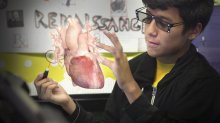Will Virtual Reality Drive Deeper Learning?
As an ever-growing array of virtual reality tools hits schools, educators wonder if the technology lives up to its hype.
Though no hard numbers are available yet on how many K–12 classrooms are using virtual or augmented reality, new estimates suggest the technology could reach 15 million students by 2025.
But without research to show the impact, experiences like landing on the moon or the sinking of the Titanic could be closer to entertainment than education, argue critics, who say much of what’s being marketed as virtual reality is not groundbreaking—or even new. Computer scientists first began experimenting with “virtual experiences” in the 1950s, and by the 1980s goggles and gloves had been developed to simulate immersion in a virtual world.
“My question is always: How is virtual reality different from educational film?” asks Audrey Watters, who speaks extensively on the role of technology in education and writes the blog Hack Education. “I do worry that we’ll increasingly substitute watching a movie—under the guise of simulation or VR—for field trips and other offline enrichment opportunities that are more meaningful.”
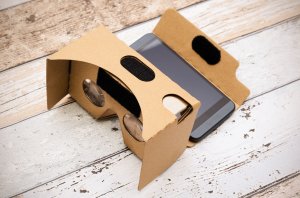
There’s also the price tag. Headsets and gloves can cost hundreds of dollars, making it challenging for most school systems to provide universal access. While cheaper versions exist—such as the $15 Google Cardboard, which attaches to a smartphone—these versions often don’t provide the same quality of experience. In fact, critics say much of what is now called virtual or augmented reality by schools isn’t experienced through headsets and gloves, but on laptops, tablets, and phones instead. In other words, many people still aren’t sure exactly what VR is, and the definition is continually evolving.
For VR advocates like Maya Georgieva, though, the technology is rapidly changing the way we see and experience the world. Georgieva, the co-founder of Digital Bodies—a group that researches and consults on VR for education—says that while virtual reality is still seen as supplemental in K–12 classrooms, that thinking is shifting as the volume of content increases and teachers and students feel the excitement around it.
“We are hearing from teachers unanimously that these experiences generate more questions and more engagement in students,” she said. “For children, it often takes time to create a mental model of what they are learning. Virtual reality provides them with a stepping stone—and possibly a leap—to connect the dots.”
Proponents of the technology can point to real success stories: Here are some of the more promising uses of VR and other immersive technologies already underway in K–12 classrooms across the country.
Bringing Science to Life
Like doctors who have been using VR to assist in surgeries and pinpoint ailments—by generating 3D models of real patient tumors from MRI scans, for example—science teachers are saying VR can help deepen understanding of subjects such as biology and anatomy, which require students to grasp the inner workings of cells and organs that are not visible to the human eye.
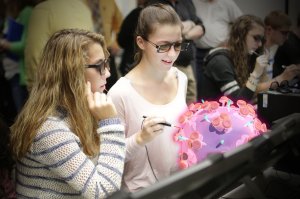
In Belmont, California, high school biology teacher Rebecca Girard has been using mixed reality computers from zSpace—which come with special glasses that allow cells and organs to “pop out” of the flat screen in 3D—to help her students gain a better grasp on how the heart works. Using apps like Cyber Science, zSpace Studio, and Human Anatomy Atlas, Girard’s students can follow the path of blood flow through arteries as the heart beats, watching valves open and close.
“Real organs used in dissection are preserved and inflexible, and the valves and muscle no longer pump,” Girard said. “I have been teaching biology for 22 years, and I have never had students understand the structures, relationships, and orientations of the organs with the same clarity as when they used virtual reality.”
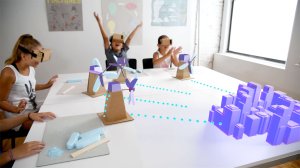
And platforms like Peer have developed mixed reality content for students that provides compelling visual models of complex physical science concepts like gravity, molecular bonds, and force. Using Peer, students can uncover the aerodynamics of a windmill through a VR headset, for example, and then apply their newfound understanding to build a windmill of their own.
Experience Campus Life From Home
Touring colleges is costly and time-consuming, not to mention impossible for many potential college students. Companies like Campus Tours and YouVisit are now offering 360-degree virtual reality tours for hundreds of campuses, from the Georgia Institute of Technology to the University of Minnesota. According to YouVisit, the experiences help foster a “sense of familiarity and belonging” for students who can’t make the trip—and might encourage students to consider more schools.
Using any device (no fancy headset needed), prospective students can “walk” on the paths around campus and “see” themselves among other college students, headed to class or back to the dorms. By clicking on campus buildings, users can get inside and access more than 1,000 college experiences like exploring Geisel Library at the University of California, San Diego, or an electrical engineering lab at Princeton University.
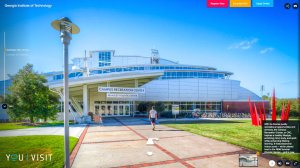
“It’s human nature to want to really look around a place and get a genuine sense of what it’s like,” said Gordon Meyer, director of marketing for YouVisit. “Immersive experiences are the best way to provide that opportunity, especially for students who are unable to travel and physically tour the campus.”
Building Empathy
To really understand someone’s perspective, you have to “walk a mile in their shoes,” as the saying goes. By giving students the ability to see through another’s eyes and “experience anything the animator can fathom,” VR has earned the nickname “the empathy machine.”
This year, the nonprofit Global Nomads piloted the One World, Many Stories program, which used virtual reality to build connections between 20 classrooms in the United States and the Middle East. Through the program’s VR simulations, students are able to walk the streets with a teen in Jordan or rural Kentucky and be immersed in their day-to-day life, gaining understanding of other cultures and viewpoints along the way.
A group of Los Angeles high school students at a school in Compton were able to “drop in” to the heart of Aleppo, Syria, through the VR simulation and experience the impact of an explosion, which helped them gain perspective about life during wartime. Afterward, the Compton students had a video dialogue with Syrian youths in a refugee camp to discuss their experiences.
“I never dreamed that I was going to take it to high school students, who might be able to make changes in the lives of Syrian children refugees,” said Nonny de la Peña, who created the simulation.
Also showing promise: Embodied Labs is providing training for students to become better caregivers for the elderly by letting them experience the medical challenges seniors face, like macular degeneration and hearing loss. In the simulation “We are Alfred,” users experience the impact of vision impairment during a family birthday party.
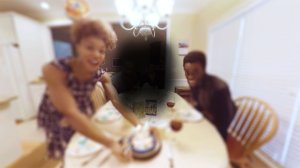
The platform was selected as one of five winners in the U.S. Department of Education’s EdSim Challenge for “immersive simulations that will prepare students for the globally competitive workforce of the 21st century.”
Shop Class, Revived
While fewer students are taking career and technical training these days, CTE may get a revival through new virtual reality experiences that train students how to repair cars and allow them to complete safety training in 3D.
Already used by the Hong Kong Institute of Vocational Education to teach aircraft engineering and building maintenance skills, the U.S.-based VR platform zSpace has now launched vocational simulations of its own, in partnership with Shenzhen GTA Education Tech Ltd. in China.
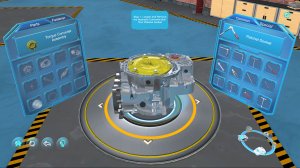
Using the zSpace auto training platform, students can disassemble and reassemble systems like the transmission or engine, free of risk or material waste.
“The new GTA Virtual Automotive Training applications take the ‘auto shop’ class of years ago to a whole new level. Traditional textbooks and courseware are two-dimensional, and hands-on training with actual cars is irreversible and expensive,” said Paul Kellenberger, zSpace’s president and CEO, in a statement, as reported by THE Journal. “With these applications, students practice repairs and techniques repeatedly, building strong skills, and schools save money and space.”
Animating History
Corey Engstrom’s fifth-grade students built an early American colony this year, populating it with figures from history—but instead of using clay, cardboard, and glue, they made the colony digitally, inside a virtual world. Using the platform CoSpaces Edu, which allows users to create their own virtual reality experiences, the students animated their colonists to buy and sell goods, board merchant vessels, and head out to sea for trade.
Engstrom’s class isn’t equipped with expensive headsets and gloves; students created the colonies on the flat screens of their Chromebooks instead. After creating a virtual world, CoSpaces users can don basic cardboard headsets to bring their visions to life in 3D, or choose to engage on a computer or tablet. The platform was recognized as a finalist in EdTech Digest’s Cool Tools awards this year.
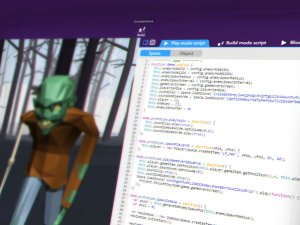
Even without fancy equipment, Engstrom said, the experience allowed students a chance to get a feel for what life was like long ago while gaining a better understanding of history.
“There’s no replacement for an actual field trip,” said Engstrom, who runs an online VR community that helps educators interested in the technology connect. “But virtual reality does provide an opportunity for a new level of immersion to a place they’ve never been—or like colonial America, a place they’d otherwise be unable to go.”
